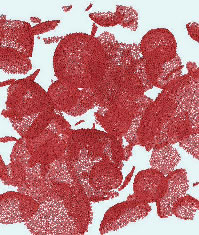Biomembrane Molecular Simulation That Explicitly Includes Solvent Molecules in an Effort to Achieve Massively Parallel Computing
 An endless variety of cell membranes, red blood cells and other membrane structures formed by molecular assemblies can be found in the body. These membrane structures are molecular assemblies that have lipid molecules and surfactants that accompany hydrophilic and hydrophobic groups as their main structural components. They have many intriguing aspects, ranging from the properties of the individual molecules to their macro structural formation, uneven distribution of various components within the cell membrane and so on, and they constitute a boundary area that is being approached from not only biology but chemistry and physics as well. These materials are one example of the soft matter accompanying nonequilibrium phenomena that are controlled by large spatial and temporal scales. They are currently the subjects of wide-ranging exploration, from carefully controlled scientific experiments to practical industrial applications.
An endless variety of cell membranes, red blood cells and other membrane structures formed by molecular assemblies can be found in the body. These membrane structures are molecular assemblies that have lipid molecules and surfactants that accompany hydrophilic and hydrophobic groups as their main structural components. They have many intriguing aspects, ranging from the properties of the individual molecules to their macro structural formation, uneven distribution of various components within the cell membrane and so on, and they constitute a boundary area that is being approached from not only biology but chemistry and physics as well. These materials are one example of the soft matter accompanying nonequilibrium phenomena that are controlled by large spatial and temporal scales. They are currently the subjects of wide-ranging exploration, from carefully controlled scientific experiments to practical industrial applications.
From a physics perspective, the effect on membrane structure, form transition and time-dependent dynamics of the properties that are derived from the membrane elasticity of the two-dimensional membrane, in-plane flow, crystallization and so on have been debated since the 1980s. The "coarse-grained molecular dynamics method" is a method that has been used since the 1990s as a convenient way of studying large spatiotemporal scale dynamics. As it is difficult to include all of the all-atom molecules in the simulation, this method uses a single particle to represent the degree of freedom of multiple atoms to the extent that this is able to reproduce the macroscopic structure and dynamics.
Particularly in calculations in the field of chemistry, methods of solving the movement of membrane molecules as part of the same system as solvent molecules have become quite popular in order to study the effect of environmental solvents surrounding the membrane (osmotic pressure). However, there are many matters that need to be explained from a physics perspective as well. We decided to include the solvent into a meshless membrane model with a large degree of coarsegraining as part of the same system. The meshless membrane model is a highly idealized coarse-grained molecule model based on membrane elasticity theory, in which the shape of the monolayer membrane is formed spontaneously. It enables membrane cleavage, vesicle self-assembly and fusion and so on to be reproduced. Our aim is to use this model to gain a complete picture of nonequilibrium phenomena, such as the structural transitions of the membrane in which solvents are involved.
 In the midst of nearly a million solvent particles (not shown), the particles (red) that have been made coarse-grained based on a meshless membrane
In the midst of nearly a million solvent particles (not shown), the particles (red) that have been made coarse-grained based on a meshless membrane
model form a quasi two-dimensional membrane structure. Creating a rational visualization method for solvent degree of freedom is also an important
research topic.



